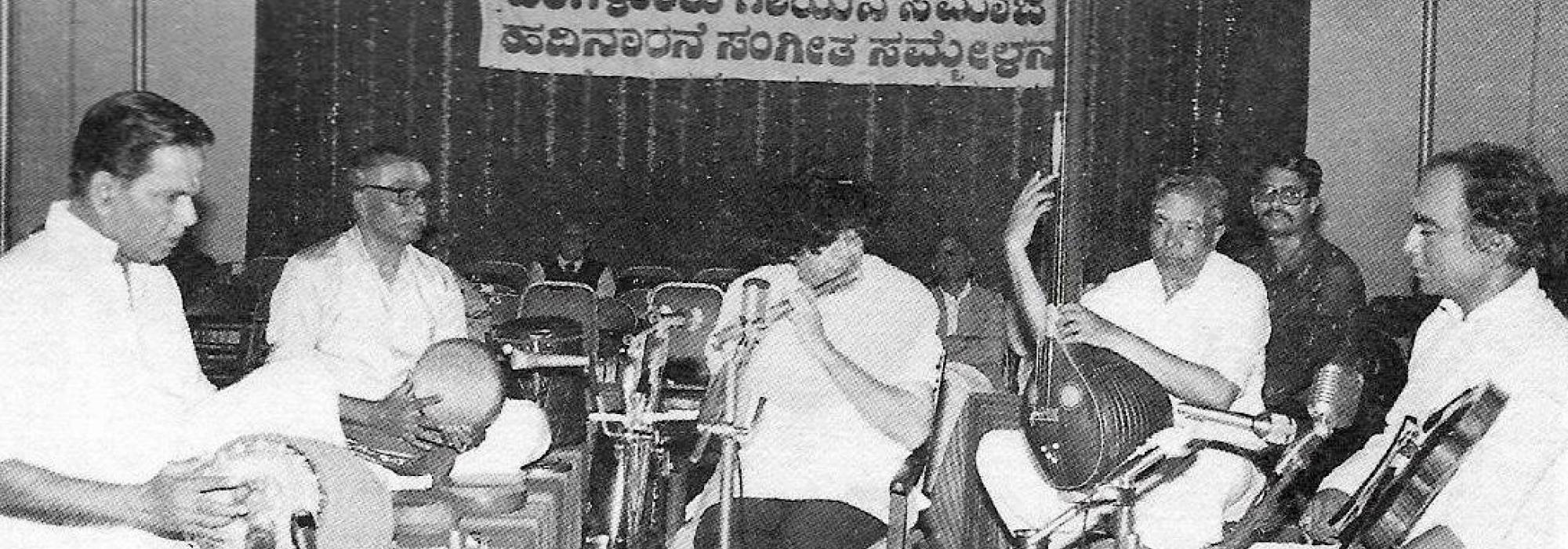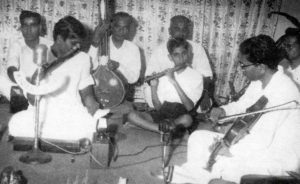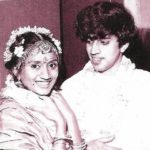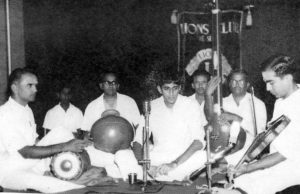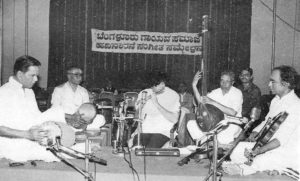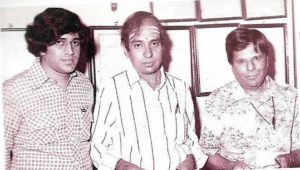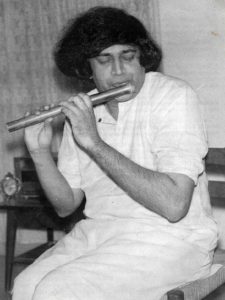It is usually thought in the world of classical arts, especially in the Carnatic circles in India that a prodigy is born in a family which is rich with a music tradition, and in most cases, belonging to the lineage of one of the stalwarts. It is rather rare to find a genius being born in an unconnected atmosphere. When the eight-holed bamboo flute was still trying to figure out its place in main stream Carnatic music as a solo and an accompanying instrument and when the playing techniques developed by Mali (TR Mahalingam) were awaiting to be housed in a creative musician, Bangalore N. Suresh was born.
Early Years and Training
Suresh was born on 7th January 1946 in Bangalore, as the son of B. Nilakantan, an engineer and Jayalakshmi, a home maker. Even as a toddler, he enjoyed listening to the songs sung by his mother and could sit through music concerts of 5-6 hrs duration. Once, when he was about three, he witnessed a veena-vocal recital by Nilamma Kadambi at Nanjangud. He sat by the side of the artist on the stage and at the end of the concert, patted the instruments with unbounded joy. By then, music had cast its spell on him. ‘Get me a teacher to teach flute’- the boy demanded soon after. The boy was put under the tutelage of M.S. Srinivasmurthy, whose lessons he quickly outgrew. He would skip the mechanical drill in musical notes and land on his favourite Mali-tunes, which had fallen on his receptive ears by then. It seemed as though Suresh was ‘possessed’ by Mali-tunes and the teacher had to tailor his lessons to suit the boy’s taste.
In the music festival the following year, seven year old Suresh was presented to Mali, the great flute wizard of those times. Mali gave his flute to Suresh and was enchanted by the tonal quality displayed by the little one. He was willing to tutor the boy himself, but as he was not residing in Bangalore, he suggested the parents to take Suresh to B. Sivaramiah. The happy symbiosis of the loving teacher and the talented pupil developed into a creative playing style and a rising star in Suresh. Mali, who was monitoring the boy’s growth, invited Suresh to accompany him in a concert in 1955 at the Century Club in Bangalore. Nine year old Suresh, out of innocence and innate confidence accepted the offer to play a duet with the 29 year old star. The concert, which was purely based on the manodharma (creative elaboration) was staged without any rehearsal.
At the end of the recital, an impressed Mahalingam declared “It is only Suresh who can and will carry my mantle. None else has the capacity”. Little did he know that Suresh would outgrow even the technical framework put by Mali, by his sheer talent and creative genius.
The first prominent solo concert of BN Suresh was hosted by the Theosophical society of Bangalore on 7th July 1956. It announced “a musical soiree: flute by Master Suresh Nilakantan (boy prodigy aged 10)”. Music critics including seniors such as G.T. Narayana Rao later hailed him as the “Child-Pied Piper of Bangalore”. Concerts kept coming in search of the child prodigy. The Bangalore Gayana Samaja invited him for a performance in November 1957. In the words of a senior music critic decades later, “The veteran members of the Samaja will recall the scene several years ago here, when the Secretary V.T Srinivasan had literally carried a ten-year old lad to the stage from among the audience. The boy was absorbed in fondly caressing an ordinary bamboo stick. The elixir of melody he poured out of it simply metamorphosed us: never was heard such captivating melody before…. Mali was prominently seated among the rasikas (connoisseurs) ”
Suresh soon got invitations from Madras, the Kashi of Carnatic music. Although the senior accompanists in Madras were skeptical and took it almost as an insult to play along with an eleven year old kid, Suresh’s first piece, the Viriboni varnam in vilamba and trishra paces alerted them and challenged them to provide him the best support. “The young master is a master artist”, they remarked.
The Holy Mother of the Aurobindo Asram, Pondicherry saw a little Krishna in him when he was invited for a performance there. Right after the concert, when the Mother was meaning to have a word with him, he had vanished from the concert hall. He was later found with his father at an ice -cream stall nearby. The loving father had often used ice-cream as a bait for making Suresh give performances. The boy was then brought to the Holy Mother, who offered him fruits. The little boy, oblivious to the decorum and code of conduct in the presence of the Mother, picked up a fruit and started relishing it. The parents were visibly embarrassed. However, the Mother said, ‘That’s precisely the way Lord Krishna would have acted” and eased their anxiety.
Career and Family
A career in arts was not seen as a means of earning a livelihood in urban middle class families in India, as is true even to this day. This made Suresh pursue his bachelors in Electrical Engineering from the BMS College, Bangalore. He graduated in 1969 and immediately joined ITI Ltd as an engineer. He started his family life in 1975 by marrying Sudha and in 1982, his daughter Sruti was born.
Suresh’s career as a mainstream solo flautist was at its peak in the 60s and 70s. Bangalore K Venkataram served as his friend, philosopher and guide in his music career. Even as a 13 year old boy, he was staged with stalwart accompanists such as Parur M.S. Gopalakrishnan (MSG) on Violin (1959). In his fourteenth year, he have invited for a private jugalbandhi (duet) concert with the Sitar maestro Pandit Ravi Shankar. M.S Subbulakshmi too invited him for a two-hour recital in private and remarked “I felt as if the Lord Himself was playing His divine tunes”. His stature further rose in 1967, when senior musicians such as Lalgudi Jayaraman (violin) and Umayalpuram Sivaraman (mridangam) readily accompanied the 21 year-old for his concert.
Suresh was graded the A-top artist in the AIR and was often invited for national programmes. He was nominated twice as a member of Karnataka Sangeeta Nritya Academy. He took a keen interest in its activities and helped the deserving artists from Karnataka get stage both within and without the State. He encouraged classicism in younger artists and worked for their welfare. He was also invited to give over 40 concerts in the US and Canada in the late 70s and early 80s.
Suresh was a loving teacher and trained several flautists. Loka V Shankar, TR Srinath and BK Anantaram are among his prominent students from Bangalore. He had students coming to him for the enrichment of both technique and content from different parts of India and abroad.
In early 1983, Suresh had a tragic fall right after having a nice oil bath at his house, which was also a fall in his career as a flautist. He had slipped in the bathroom and ended up with a fracture in the right hip bone and a deep wound in the right shoulder. It took him over a year to recover from the injuries. He slowly moved back to stage sitting on a wheel chair, as he could not squat. The critics and the press in Madras, however, did not take kindly to Suresh’s chair-music. Their non-academic observations and criticism of peripheral aspects hurt his sensitive mind. A fold-able wooden seat was innovated on which he could squat with some effort, thus removing the critics’ objections. Nevertheless, it was painful for Suresh to sit on such a seat and it took him days to recover from the pain after giving a concert.
In April 1990, Suresh suffered yet another fracture in his left arm. The words of a self-proclaimed fortune-teller who had said that Suresh would not live beyond his forty-fifth year was bothering him subconsciously and made him emotionally weak. He gave his last performance in Mysore on June 29th 1990 and did a small concert tour of Andhra Pradesh. He suddenly fell ill in September and breathed his last on 7th October 1990 at the age of 44. Just before his final fateful turn, he was imploring to his mother, ‘Cure me soon. I want to give expression to my novel innovative ideas. You please take them and preserve for posterity’.
BN Suresh’s music
The bamboo flute, which is one of the oldest instruments, though simple in its form had not gained the status of a main concert instrument until the late 19th century. Sarabha Shastry and Palladam Sanjeeva Rao were the pioneers in giving independent flute recitals. However, their technique was harsh and could not capture audiences for long hours. Moreover, in the Carnatic system of music, instrumentalists are to imitate vocal compositions. Musical tunes, structures and idioms which are purely meant for instruments have not evolved in the carnatic system, unlike its western counterpart. Thus, in the pre-Mali days fingering and blowing techniques that could help imitate a vocal rendition accurately and give flute its own flavor at the same time, had not evolved.
Although it was Mali who developed a playing technique suitable for flute, he lost interest in flute in his later years. He would try his best to avoid facing a concert and would resort to only gimmicks when forced to come on stage. Even stalwart accompanists would find it difficult to cope up with his unpredictable behavior on stage. It was rare to hear Mali playing flute without interruptions. His playing was always broken with sudden pauses and gaps for no reason. Sensitive rasikas found it hard to find aesthetic joy in Mali’s concerts, due to his own lack of seriousness.
Mali chose a high-pitched flute, usually 4 or 5 (F or G) and so did Suresh. The latter even said “A low-pitched flute is no different from the goldsmith’s wind-blowing pipe”. Although this can be seen as his personal choice, given that most main stream Carnatic flautists today employ a lower pitched flute (D or D#) as they are less shrill, it must be acknowledged that higher the pitch, greater the clarity of notes. It is also tougher to handle higher pitches, as an ‘apasvara’ (a wrong note) is heard prominently too, as are the good notes. Thus it requires a greater mastery over svara-sthaanas (relative frequency levels of notes) while working with a higher pitched instrument. Lower-pitches are slightly more tolerant to deviation in svara-sthaanas. Moreover, as the holes are more closely spaced in a higher-pitched flute, one can avoid over-stretching of fingers. Perhaps, Mali and Suresh adopted such flutes taking these aspects into consideration. However, despite these technicalities, from the point of view of pure aesthetics, a lower pitched flute seems to be the favourite of most connoisseurs today.
The foundation for the cross-fingering technique that Mali had laid was developed by Suresh. Cross-fingering, unlike parallel fingering could bring out better nuances in gamaka-s (embellishments) on the flute. Phrases in raagas that were unimaginable before were possible due to this technique. The ‘tuttukaaras’, i.e., using the tongue while blowing at appropriate places, helped in delineating the lyrics of a song accurately. Just like the strings on a veena are plucked when the syllables of a song occur, a tuttukaara was to be given on flute on the very same syllables. This brought flute playing closer to the ‘gaayaki’ style and impressed connoisseurs, who were already familiar with vocal renditions of popular compositions. Having said this, instrumentalists including Suresh never forgot that imitation at its best is only second rate compared to a vocal rendition. He made sure that his playing technique was subservient to the aesthetic experience, which, in his own words, was the main purpose of music.
To enrich the content of his music, Suresh had tuned his antenna to the maestros of his days. He passionately listened to GN Balasubramaniam, ML Vasantakumari (MLV), MS Subbulakshmi and Alathur brothers amongst others. He was greatly influenced by the raaga elaboration of MLV. Suresh always remarked that he "sang through his flute". Rather than thinking of a kriti (a lyrical composition) through its svaras, he actually sang the song in his mind and his fingers effortlessly translated it into the flute-medium.
Suresh was famous for his handling of raagas such as Keeravani, Simhendramadhyama, Shuddha Saveri and Hemavati, which were unexplored in those days on flute. He was fond of playing devaranaamas popularized by MLV in those days. Intensely enjoying the lyrics, he would lose himself while playing ‘Srikantha enagishtu dayamaado tande,’ while enjoying the pathos in the raaga Darbari Kanada. Suresh actually meant the lyrics and deeply prayed for better health during his last years. Sometimes, he even started his concerts with a devaranaama, which was a deviation from the set pattern of carnatic music concert in those days. He brought in sanchaaras (phrases of notes) typical to flute in compositions like Raghuvamshasudha.
Suresh aimed at evolving a musical style called the ‘Bharatiya’, blending the best of the Carnatic and Hindustani styles. He experimented by playing Hindustani tunes on a high-pitched Carnatic flute and vice versa. He even gave experimental concerts on the ‘Bharatiya flute’ in private.
In one of his several interviews, he had remarked, ‘One should judge an artist by the art he produces, keeping every other consideration outside the purview.’ His advice to aspiring flautists was – ‘Learn flute from flautists only. Listen to other artists and assimilate the best rejecting the junk. Let no money or fame lure you off the path of creative music. Never grow stale or desperate.’
Suresh’s long-play record of HMV with Lalgudi Jayaraman, Vellore Ramabhadran and Bangalore K Venkataram has been a best-seller for decades. Connoisseurs even to this day treasure their personal recordings of Suresh’s concerts and a few have made it available on the internet.
G.T. Narayana Rao, a senior music critic remarks, “People of my generation who have witnessed the birth, evolution, achievements and premature demise of the phenomenon called Suresh will recall with deep feelings, the eternal melodies he breathed through his live instrument, and the evergreen quest he cast through his inquisitive eyes. A solitary note, a gentle curve, a caressing gamaka, or a mischievous tilt would convey the essence of the intended raga, and also suggest the kriti likely to follow. It was like a single ray of light from a distant Blue Giant star: so rich in content.”
To mark his first death anniversary, ‘Flute B.N Suresh Smaraka Samiti’ was established. It brought out a booklet called ‘The Poet of Flute – BN Suresh in words and pictures’ in October 1991. In its preface, the Samiti remarks – ‘the untimely demise of Flute BN Suresh is a quadruple tragedy: he died young, his death was not inevitable, a great artist was lost in him and his zest for life and concern for excellence were permanently interred with him. For his Kith and Kin, the wrench is a personal agony, and for the society, it is the sudden stilling of a melody of rare hues. He has vanished like a dream. But the raagas he enlivened continue to kindle the hearts of all those who came under his spell’.
Flautists of today perhaps remember BN Suresh primarily for his contribution to playing techniques rather than content development. An instrument is after all an obstacle which needs to be tackled when creative ideas in music need to be expressed. Each instrument has its limitations and tries futilely to get closer to vocal music, especially in the carnatic genre. Suresh needs to be credited for his balance in handling both the technique and content, at a time when flute did not have the independent identity which it has today. The field of Carnatic music and flute in particular, has probably progressed from the point where Suresh left it. However, we need to be grateful to the foundations laid by maestros like BN Suresh.
References
The poet of flute. Flute BN Suresh Smaraka Samiti, Jaganmohan Palace, Mysore (1991)
This article has largely drawn from the conversations the author had with his teacher Ms. Loka V Shankar, an eminent flautist and the primary student of BN Suresh. It also draws from the views expressed by musicians who accompanied BN Suresh in his concerts. Some parts of the article are paraphrasing of an essay with the same title by G.T. Narayana Rao.

